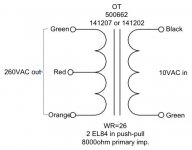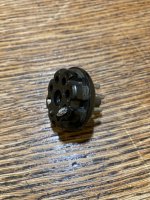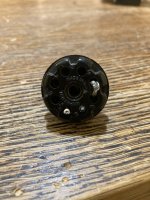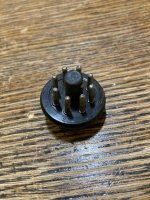Greetings all,
I'm new to the forum and this is my initial post.
I acquired a power amp from a Wurlitzer Sideman with the intent of scavenging the parts to build a guitar amp. The amp itself has one 12ax7 preamp tube and a pair of EL84s in push-pull (I'm assuming). I didn't find any diodes and there was an empty octal tube socket that I'm guessing was for the rectifier. From what I've found on the web, the Sideman was manufactured from 1959-1965. My intent for scavenging these parts was to build an AC-15 type amp. After spending much time, I've been unable to find a schematic for this unit. It's a Wurlitzer 501510 power amp.
After pulling the transformers, sorting out the continuity of the windings, and passing voltage through them to identify the ratios, I have come up with the following diagrams and measurements for the PT and OT (see attached). Note the voltages I've measured represent an unloaded circuit.
The numeric codes stamped into both transformers are indicated on the diagrams. I wasn't able to find any information on these using the code numbers. I also wasn't able to find any equivalent modern construction transformers to compare to (at least for the PT).
My questions to the forum are the following:
For the PT:
1) What's the deal with a 136V B+ secondary and how is it possible to power two EL84s and a 12ax7? I measured that multiple times and got the same result. That voltage doesn't seem to be particularly useful in a tube amp.
2) What purpose does a 34V secondary serve? Would this be used for a rectifier filament?
For the OT:
1) For two EL84's in push-pull, the secondary output represents 12 ohms. 12 ohms? From what I could find, the Sideman had a 4ohm speaker. Something doesn't add up. I ran 10 v ac into the secondary an measured 260 v in the primary (130 CT). I calculated a winding ratio of 26.
If you have any insight into these transformers and their specs as measured, your input would be greatly appreciated. I'm hoping I didn't acquire some old doorstops.
In addition, I found this part (see attached pics) inserted into one of the octal sockets. Any idea what its purpose is?
Thanks in advance.
I'm new to the forum and this is my initial post.
I acquired a power amp from a Wurlitzer Sideman with the intent of scavenging the parts to build a guitar amp. The amp itself has one 12ax7 preamp tube and a pair of EL84s in push-pull (I'm assuming). I didn't find any diodes and there was an empty octal tube socket that I'm guessing was for the rectifier. From what I've found on the web, the Sideman was manufactured from 1959-1965. My intent for scavenging these parts was to build an AC-15 type amp. After spending much time, I've been unable to find a schematic for this unit. It's a Wurlitzer 501510 power amp.
After pulling the transformers, sorting out the continuity of the windings, and passing voltage through them to identify the ratios, I have come up with the following diagrams and measurements for the PT and OT (see attached). Note the voltages I've measured represent an unloaded circuit.
The numeric codes stamped into both transformers are indicated on the diagrams. I wasn't able to find any information on these using the code numbers. I also wasn't able to find any equivalent modern construction transformers to compare to (at least for the PT).
My questions to the forum are the following:
For the PT:
1) What's the deal with a 136V B+ secondary and how is it possible to power two EL84s and a 12ax7? I measured that multiple times and got the same result. That voltage doesn't seem to be particularly useful in a tube amp.
2) What purpose does a 34V secondary serve? Would this be used for a rectifier filament?
For the OT:
1) For two EL84's in push-pull, the secondary output represents 12 ohms. 12 ohms? From what I could find, the Sideman had a 4ohm speaker. Something doesn't add up. I ran 10 v ac into the secondary an measured 260 v in the primary (130 CT). I calculated a winding ratio of 26.
If you have any insight into these transformers and their specs as measured, your input would be greatly appreciated. I'm hoping I didn't acquire some old doorstops.
In addition, I found this part (see attached pics) inserted into one of the octal sockets. Any idea what its purpose is?
Thanks in advance.
Attachments
Welcome.

This disagrees with a tube rectifier. (Such doubler tubes were made but for smaller powers and odd heater voltages.)
The original power supply wiring should work as-is. Or has a previous owner chopped it up?
What's the deal with a 136V B+ secondary and how is it possible to power two EL84s
This disagrees with a tube rectifier. (Such doubler tubes were made but for smaller powers and odd heater voltages.)
The original power supply wiring should work as-is. Or has a previous owner chopped it up?
The date does suggest vacuum rectifier but it could go either way in that period. The diodes may not be familiar to modern eyes.an empty octal tube socket that I'm guessing was for the rectifier. .... 1959-1965
The octal on the end is almost certainly for speaker and other external connections. Church organs had scads of round sockets.
It must have been a voltage doubler to get the V+ in the neighborhood of 300V. Remember, these organs marched to their own drummer, pun intended, and used whatever impedance speaker they wanted in their designs. A 12 ohm speaker was not out of the question. This also crated a captive audience for replacement parts.
Thank you very much for sharing your thoughts. Unfortunately the original wiring has been “modified”. 🤣Welcome.
View attachment 1051212
This disagrees with a tube rectifier. (Such doubler tubes were made but for smaller powers and odd heater voltages.)
The original power supply wiring should work as-is. Or has a previous owner chopped it up?
What sort of capacitance values (C1, C2) would you expect in a voltage doubler circuit as you’ve illustrated?
I ended up finding two diodes in the rats nest of wires that came with the unit. As you’ve indicated, in all likelihood there wasn’t a rectifier tube.The date does suggest vacuum rectifier but it could go either way in that period. The diodes may not be familiar to modern eyes.
The octal on the end is almost certainly for speaker and other external connections. Church organs had scads of round sockets.
View attachment 1051216
🤣It must have been a voltage doubler to get the V+ in the neighborhood of 300V. Remember, these organs marched to their own drummer, pun intended, and used whatever impedance speaker they wanted in their designs. A 12 ohm speaker was not out of the question. This also crated a captive audience for replacement parts.
Thanks so much for your comment! Would you expect any issues running either an 8 or 16 ohm speaker with this OT?
The Wurlitzer Sideman is NOT an organ it is the first drum machine in existence. It used a mechanical sequencer which was made with a round PC board having contacts and a rotating wiper in the center. I had one of these in the late 60's but never ripped into its electronics, as mine needed some mechanical repairs. The PC board was worn out.
The odd voltage winding on the transformer may have been for the motor, or for the drum sound generator which used neon light bulbs. The tempo was mechanically changed as the motor ran at a constant speed. The octal socket that had the octal plug in it runs power to the tone (drum sound) chassis.
https://120years.net/wordpress/the-side-manwurlitzerusa1959/
The odd voltage winding on the transformer may have been for the motor, or for the drum sound generator which used neon light bulbs. The tempo was mechanically changed as the motor ran at a constant speed. The octal socket that had the octal plug in it runs power to the tone (drum sound) chassis.
https://120years.net/wordpress/the-side-manwurlitzerusa1959/
Last edited:
- Home
- Design & Build
- Parts
- Wurlitzer Sideman Transformer ID help




